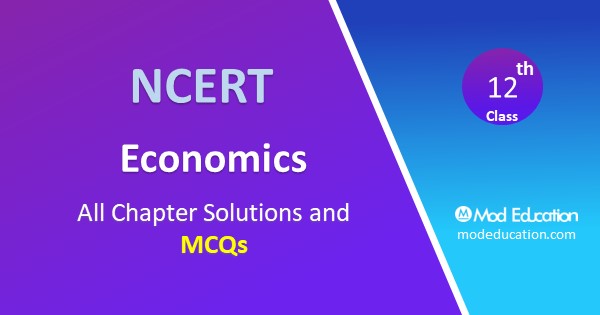MCQ Questions for Class 12 Economics Chapter 6 : Class 12 Chapter 6 “Open Economy Macroeconomics” MCQ Questions for Class 12 Economics with Answers PDF Free Download here according to the latest CBSE syllabus and NCERT curriculum.

MCQ Questions for Class 12 Economics Chapter 6 Open Economy Macroeconomics with PDF
Here CBSE RBSE and Other State Board NCERT Objective MCQ Questions of Class 12 Economics Chapter 6 “Open Economy Macroeconomics” with Answers Pdf will guide students to do a quick revision for all chapter.
Q1. The operation of future delivery in the foreign exchange market is known as __
(A) Spot market
(B) Current market
(C) Forward market
(D) Domestic market
(C) Forward market
Q2. Hybrid in management of fixed and flexible exchange rate is known as __
(A) Managed to float
(B) Crawling Peg
(C) Wider Bands
(D) None of these
(A) Managed to float
Q3. When was the gold standard abandoned?
(A) 1930’s
(B) 1920’s
(C) 1940’s
(D) 1950’s
(B) 1920’s
Q4. Trade of visible items between the countries is known as __
(A) Balance of Payment
(B) Balance of Trade
(C) Deficit Balance
(D) All of these
(B) Balance of Trade
Q5. When the import and export of visible items are equal, the situation is known as _
(A) Balance of Trade
(B) Balance of Payment
(C) Trade Surplus
(D) Trade Deficit
(A) Balance of Trade
Q6. When there is a favourable balance of trade?
(A) X > M
(B) X = M
(C) X < M
(D) None of these
(A) X > M
Q7. When there is unfavourable balance of trade?
(A) X > M
(B) X = M
(C) X < M
(D) None of these
(C) X < M
Q8. The trade of visible and invisible items is known as _
(A) Balance of Payments
(B) Balance of Trade
(C) Deficit of interest
(D) Profit
(A) Balance of Payments
Q9. Other things remaining unchanged, when in a country the price of foreign currency rises, national income is:
(A) Likely to rise
(B) Likely to fall
(C) Likely to rise and fall both
(D) Not affected
(A) Likely to rise
Q10. Other things remaining the same, when in a country the market price of foreign currency falls, national income is likely:
(A) To rise
(B) To fall
(C) To rise or to fall
(D) To remain affected
(B) To fall
Q11. Which one is the king of the exchange rate?
(a) Fixed Exchange Rate
(b) Flexible Exchange Rate
(c) Both (a) and (b)
(d) None of the above
(c) Both (a) and (b)
Q12. Which of the following is true?
(a) Fixed exchange rate is determined by the government
(b) Flexible exchange rate is determined by market forces (demand and supply of foreign exchange)
(c) Both (a) and (b)
(d) None of the above
(c) Both (a) and (b)
Q13. Which one is a kind of fixed exchange rate?
(a) Gold Standard System of Exchange Rate
(b) Bretton Woods System of Exchange Rate
(c) Both (a) and (b)
(d) None of the above
(c) Both (a) and (b)
Q14. Which one is a merit of the fixed exchange rate?
(a) Promotes Foreign Trade
(b) Induces Foreign Capital
(c) Increases Capital Formation
(d) All the above
(d) All the above
Q15. Which one is a demerit of the fixed exchange rate?
(a) Ignores National Interests
(b) Restricted Movement of Capital
(c) Sudden Fluctuations in Exchange Rates
(d) All the above
(d) All the above
Q16. Which one is a merit of the flexible exchange rate?
(a) Simple System
(b) Continuous Adjustments
(c) Improves Balance of Payments
(d) All the above
(d) All the above
Q17. Which one is a demerit of the flexible exchange rate?
(a) Bad Results of Low Rate
(b) Uncertainty
(c) Instability in Foreign Exchange
(d) All the above
(d) All the above
Q18. Which one is a source of the demand for foreign exchange?
(a) Imports of Goods and Services from Abroad
(b) Investment in Foreign Nations
(c) Gift Scheme to Foreign Nations
(d) All the above
(d) All the above
Q19. Foreign exchange is determined by:
(a) Demand for foreign currency
(b) Supply of foreign currency
(c) Demand and supply in the foreign exchange market
(d) None of the above
(c) Demand and supply in the foreign exchange market
Q20. The forms of foreign exchange market is/are:
(a) Spot market
(b) Forward market
(c) Both (a) and (b)
(d) None of these
(c) Both (a) and (b)
Q21. The foreign exchange rate is determined by:
(a) Government
(b) Bargaining
(c) World Bank
(d) Demand and Supply forces
(d) Demand and Supply forces
Q22. By exchange rate we mean:
(a) How much local currency we have to pay for a foreign currency
(b) How much of a foreign currency we have to pay for another foreign currency
(c) The rate at which foreign currency is bought and sold
(d) All of these
(d) All of these
